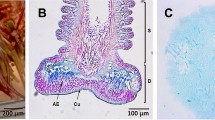Summary
During encystment,Phytophthora cinnamomi zoospores bind firmly to the host surface. We have developed a microassay to study adhesion of the zoospores to solid surfaces, both biological and non-biological. The results show that timing of the acquisition of adhesiveness during encystment correlates closely with the secretion of high molecular weight glycoproteins. The adhesive phase is short lived, occurring between 1 and 4 min after induction of encystment. During this period, cells that come into contact with a variety of surfaces (glass, plastic, and onion epidermis) become firmly attached, while cells that come into contact with one of these substrata after this period are unable to bind. Our results also show that EGTA inhibits cyst adhesion, while addition of calcium promotes cyst adhesion, especially of cysts more than 4 min old. To help identify the cyst surface component involved in adhesion we tested a number of lectins for their ability to block cyst adhesion. Soybean agglutinin andHelix pomatia agglutinin, lectins which bind to the secreted high molecular weight glycoproteins, both inhibit adhesion in the presence and absence of the hapten sugar, indicating that inhibition was non-specific. Wheatgerm agglutinin, a lectin which does not bind to the cyst surface, also blocked adhesion non-specifically.
Similar content being viewed by others
Abbreviations
- SBA:
-
soybean agglutinin
References
Bartnicki-Garcia S, Sing VO (1987) Adhesion of zoospores ofPhytophthora to solid surfaces. In: Fuller MS, Jaworski A (eds) Zoosporic fungi in teaching and research. Southeastern Publishing Corp, Athens, GA, pp 279–283
—, Wang MC (1983) Biochemical aspects of morphogenesis inPhytophthora. In: Erwin DC, Bartnicki-Garcia S, Tsao PH (eds)Phytophthora. Its biology, taxonomy, ecology, and pathology. The American Phytopathological Society, St Paul, MN, pp 121–137
Edelman GM (1986) Cell adhesion molecules in the regulation of animal form and tissue pattern. Ann Rev Cell Biol 2: 81–116
Ekblom P, Vestweber D, Kemler R (1986) Cell-matrix interactions and cell adhesion during development. Ann Rev Cell Biol 2: 27–47
Furuichi N, Tomiyama K, Doke N (1980) The role of potato lectin in the binding of germ tubes ofPhytophthora infestans to potato cell membrane. Physiol Plant Pathol 16: 249–256
Gibson DM, Stack S, Krell K, House J (1982) A comparison of soybean agglutinin in cultivars resistant and susceptible toPhytophthora megasperma var.sojae (Race 1). Plant Physiol 70: 560–566
Gould J, Northcote DH (1986) Cell-cell recognition of host surfaces by pathogens. The adsorption of maize (Zea mays) root mucilage by surfaces of pathogenic fungi. Biochem J 233: 395–405
Gubler F, Hardham AR (1988) Secretion of adhesive material during encystment ofPhytophthora cinnamomi zoospores, characterized by immunogold labelling with monoclonal antibodies to components of peripheral vesicles. J Cell Sci 90: 225–235
Hamer JE, Howard RJ, Chumley FG, Valent B (1988) A mechanism for surface attachment in spores of a plant pathogenic fungus. Science 239: 288–290
Hardham AR, Suzaki E (1986) Encystment of zoospores of the fungus,Phytophthora cinnamomi, is induced by specific lectin and monoclonal antibody binding to the cell surface. Protoplasma 133: 165–173
Hemmes DE, Hohl HR (1971) Ultrastructural aspects of encystation and cyst-germination inPhytophthora parasitica. J Cell Sci 9: 175–191
—, Pinto da Silver P (1980) Localization of secretion-related, calcium-binding substrates in encysting zoospores ofPhytophthora palmivora. Biol Cell 37: 235–240
Hinch JM, Clarke AE (1980) Adhesion of fungal zoospores to root surfaces is mediated by carbohydrate determinants of the root slime. Physiol Plant Pathol 16: 303–307
Ho HH, Hickman CJ (1967) Asexual reproduction and behaviour of zoospores ofPhytophthora megasperma var.sojae. Can J Bot 45: 1963–1981
Hohl HR, Balsiger S (1986) A model system for the study of fungushost surface interactions: adhesion ofPhytophthora megasperma to protoplasts and mesophyll cells of soybean. In: Lugtenberg B (ed) Recognition in microbe-plant symbiotic and pathogenic interactions. Springer, Berlin Heidelberg New York Tokyo, pp 259–272
Irving HR, Griffith JM, Grant BR (1984) Calcium efflux associated with encystment ofPhytophthora palmivora zoospores. Cell Calcium 5: 487–500
Jaffe LF (1983) Sources of calcium in egg activation: a review and hypothesis. Dev Biol 99: 265–276
Jarvis MC (1984) Structure and properties of pectin gels in plant cell walls. Plant Cell Environ 7: 153–164
Jensen WA (1962) Botanical histochemistry. WH Freeman and Co, San Francisco, pp 408
Kogel KH, Schrenk F, Sharon N, Reisener HJ (1985) Suppression of the hypersensitive response in wheat stem rust interaction by reagents with affinity for wheat plasma membrane galactoconjugates. J Plant Physiol 118: 343–352
Longman D, Callow JA (1987) Specific saccharide residues are involved in the recognition of plant root surfaces by zoospores ofPythium aphanidermatum. Physiol Mol Plant Pathol 30: 139–150
McClay DR, Ettensohn CA (1987) Cell adhesion in morphogenesis. Ann Rev Cell Biol 3: 319–345
Menetrez ML, Spurr HW (1987) Non-specific adhesion ofPeronospora tabacina spores. Phytopathology 77: 1692
Nicholson RL (1984) Adhesion of fungi to the plant cuticle. In: Roberts DW, Aist JR (eds) Infection processes of fungi. The Rockefeller Foundation, U.S.A., pp 74–89
Nozue M, Tomiyama K, Doke N (1980) Effect of N, N′-diacetyl-D-chitobiose, the potato-lectin hapten and other sugars on hypersensitive reaction of potato tuber cells infected by incompatible and compatible races ofPhytophthora infestans. Physiol Plant Pathol 17: 221–227
Osborn M, Weber K (1982) Immunofluorescence and immunocytochemical procedures with affinity purified antibodies: tubulincontaining structures. In: Wilson L (ed) Methods in cell biology, vol 24, the cytoskeleton, part A. Academic Press, New York, pp 97–132
Sing VO, Bartnicki-Garcia S (1972) Adhesion of zoospores ofPhytophthora palmivora to solid surfaces. Phytopathology 62: 790
— — (1975 a) Adhesion ofPhytophthora palmivora zoospores: electron microscopy of cell attachment and cyst wall fibril formation. J Cell Sci 18: 123–132
— — (1975 b) Adhesion ofPhytophthora palmivora zoospores: detection and ultrastructural visualization of concanavalin A receptor sites appearing during encystment. J Cell Sci 19: 11–20
Zentmyer GA (1980)Phytophthora cinnamomi and the diseases it causes. The American Phytopathological Society, St Paul, MN, pp 96
Author information
Authors and Affiliations
Rights and permissions
About this article
Cite this article
Gubler, F., Hardham, A.R. & Duniec, J. Characterising adhesiveness ofPhytophthora cinnamomi zoospores during encystment. Protoplasma 149, 24–30 (1989). https://doi.org/10.1007/BF01623979
Received:
Accepted:
Issue Date:
DOI: https://doi.org/10.1007/BF01623979




